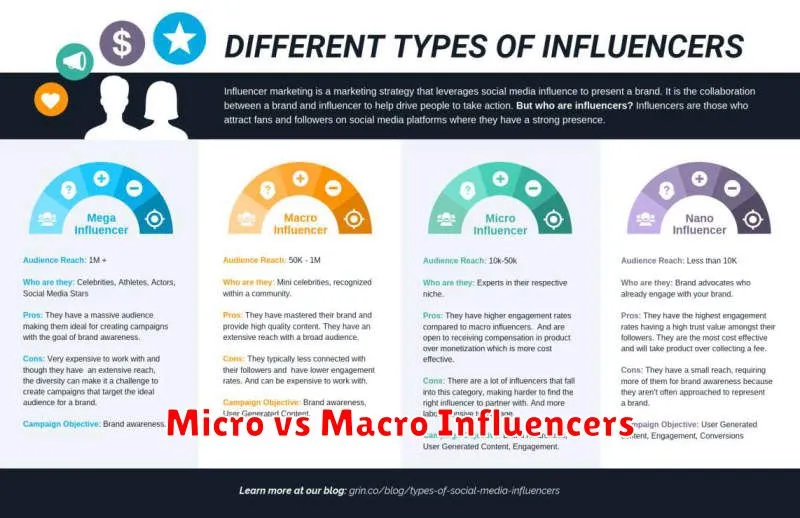Influencer marketing has become a powerful tool for businesses of all sizes, but it can be especially beneficial for small businesses looking to expand their reach and connect with their target audience on a more personal level. This comprehensive guide will provide you with everything you need to know about developing and executing a successful influencer marketing strategy, specifically tailored for the needs and resources of small businesses. From understanding the core concepts of influencer marketing to identifying the right influencers and measuring your campaign’s return on investment (ROI), this guide will equip you with the knowledge and practical advice to leverage this cost-effective marketing strategy.
Whether you’re a small business owner just beginning to explore the world of influencer marketing or looking to refine your existing approach, this guide offers valuable insights into navigating the nuances of this dynamic landscape. Learn how to identify relevant influencers within your niche, establish authentic partnerships, create compelling campaigns that resonate with your target audience, and effectively track and analyze your results. Discover how influencer marketing can be a game-changer for your small business, driving brand awareness, increasing sales, and fostering lasting customer loyalty.
What Is Influencer Marketing
Influencer marketing is a strategic marketing approach that leverages the reach and credibility of influencers to promote products or services. Influencers are individuals who have established a significant following and authority within a specific niche or industry. They possess the power to impact their audience’s purchasing decisions through their content and recommendations. This form of marketing capitalizes on the trust and engagement influencers have cultivated with their followers, leading to increased brand awareness, positive perception, and ultimately, sales.
Unlike traditional advertising, influencer marketing relies on authentic storytelling and organic content integration. Rather than interrupting the consumer experience with intrusive ads, influencer marketing seamlessly weaves brand messaging into relatable content. This approach fosters genuine connection and fosters a sense of community around a brand, which can be particularly effective in reaching younger demographics who are increasingly skeptical of traditional advertising methods.
Several types of influencers exist, categorized primarily by their audience size:
- Mega-influencers: Celebrities and online personalities with massive followings.
- Macro-influencers: Individuals with a substantial following, often within a specific niche.
- Micro-influencers: Influencers with smaller, highly engaged communities.
- Nano-influencers: Individuals with even smaller followings but often hyper-local influence.
Choosing the right influencer for a campaign depends on factors like target audience, budget, and campaign objectives.
Micro vs Macro Influencers

When devising an influencer marketing strategy, understanding the distinction between micro and macro influencers is crucial. Macro influencers typically boast a large following, often in the hundreds of thousands or millions, providing extensive reach and brand awareness. Their content tends to be more polished and professionally produced. Conversely, micro influencers have a smaller, more niche following, usually ranging from a few thousand to around 100,000 followers. They often cultivate stronger relationships with their audience, resulting in higher engagement rates and a greater sense of authenticity.
Choosing between micro and macro influencers depends on your campaign goals. If your objective is to maximize brand visibility and reach a broad audience, macro influencers may be the better choice. However, if your goal is to drive conversions and foster deeper connections with a specific target audience, micro influencers can be more effective. Consider factors such as budget, target demographic, and desired campaign outcomes when making your decision.
Ultimately, the most successful influencer marketing campaigns often leverage a combination of both micro and macro influencers to capitalize on the strengths of each. This approach can create a synergistic effect, blending broad reach with targeted engagement to achieve optimal results.
How to Find the Right Influencers
Identifying the right influencers for your brand requires careful consideration of several key factors. First, define your target audience. Understanding their demographics, interests, and online behavior is crucial. Then, look for influencers whose audience aligns with yours. Relevance is key. An influencer’s content should resonate with your brand’s message and values. Finally, consider the influencer’s engagement rate. High follower counts don’t always translate to meaningful interactions. Focus on influencers who foster genuine connections with their audience, as this will lead to more authentic and effective brand promotion.
Once you’ve identified potential influencers, research their past collaborations and brand partnerships. Ensure their values align with your own and that their previous campaigns have been successful. Transparency is essential. Look for influencers who disclose sponsored content ethically and authentically. Authenticity builds trust with their audience, making their endorsements more impactful. Consider also the scope of the influencer’s reach. Micro-influencers with smaller but highly engaged audiences can be just as effective, and often more cost-effective, than macro-influencers with millions of followers.
Finally, establish clear communication and expectations from the outset. Outline your campaign goals, deliverables, and timeline. A well-defined contract protects both parties and ensures a smooth collaboration. Collaboration is key to a successful influencer marketing campaign. Treat influencers as partners, valuing their creativity and expertise. By working together, you can create engaging and effective content that resonates with your target audience and achieves your marketing objectives.
Budgeting and Compensation Models
Budgeting and compensation models are crucial for effective financial management within any organization. Budgeting models provide a framework for planning, monitoring, and controlling expenses while ensuring alignment with strategic objectives. These models can range from traditional incremental budgeting, which adjusts prior year budgets based on projected changes, to zero-based budgeting, which requires justification for all expenses from scratch. The chosen budgeting model should reflect the organization’s size, industry, and overall financial goals.
Compensation models, on the other hand, focus on the strategies used to reward employees for their contributions. These models must balance internal equity (fairness among employees within the organization) and external competitiveness (alignment with market rates for similar roles). Factors influencing compensation models include job responsibilities, performance, skills, and experience. Effective compensation models attract and retain talent while promoting employee motivation and productivity.
The relationship between budgeting and compensation is integral. Compensation is typically a significant component of an organization’s budget, and the budgeting process often informs decisions about salary increases, bonuses, and other forms of compensation. Aligning these two processes ensures that compensation expenses are sustainable within the overall budget while also supporting the organization’s goals for attracting, retaining, and motivating its workforce.
Building Win-Win Partnerships

Win-win partnerships are built on a foundation of mutual benefit and shared success. Each partner contributes unique strengths and resources, creating synergy and achieving outcomes greater than either could accomplish alone. Successful partnerships require clear communication, defined roles and responsibilities, and a shared vision for the future. By aligning goals and working collaboratively, partners can leverage each other’s expertise to overcome challenges and achieve shared objectives.
Building a win-win partnership involves identifying potential partners whose strengths complement your own. It’s crucial to establish clear expectations and open communication from the outset. A well-defined agreement outlines each partner’s contributions, responsibilities, and expected outcomes. Regular communication and ongoing evaluation help ensure the partnership remains aligned with its goals and adapts to changing circumstances.
The benefits of successful win-win partnerships are numerous. They can lead to increased market share, access to new resources and technologies, and enhanced innovation. By pooling resources and expertise, partners can reduce costs, improve efficiency, and accelerate growth. Ultimately, a win-win partnership fosters a stronger competitive advantage and creates long-term value for all parties involved.
Contracts and FTC Guidelines
Contracts are legally binding agreements between two or more parties. They outline the terms and conditions of a transaction or relationship, and both parties are obligated to fulfill their respective responsibilities as defined within the contract. Key elements of a valid contract typically include an offer, acceptance, consideration (something of value exchanged), and mutual intent to be bound. Contracts can be written or verbal, though written contracts provide clearer evidence of the agreed-upon terms and are generally preferred, especially for complex agreements. Breach of contract occurs when one party fails to uphold their end of the agreement, potentially leading to legal action.
The Federal Trade Commission (FTC) plays a crucial role in protecting consumers and promoting fair competition in the marketplace. The FTC enforces various consumer protection laws and regulations, including those related to advertising, telemarketing, debt collection, and privacy. They also have guidelines for specific industries and practices, aimed at preventing deceptive or unfair business practices. These guidelines help businesses understand their legal obligations and ensure that consumers are treated fairly.
The FTC’s guidelines often intersect with contract law, especially concerning consumer contracts. For instance, the FTC requires certain disclosures in contracts for specific products or services, such as credit repair or telemarketing sales. These disclosures are designed to provide consumers with essential information before they enter into a contract, enabling them to make informed decisions. The FTC also prohibits unfair contract terms, such as clauses that waive important consumer rights or impose unreasonable penalties.
Content Approval and Monitoring

Content approval and monitoring ensures published content aligns with brand guidelines, legal requirements, and quality standards. This process often involves reviewing, editing, and approving content before publication. Effective monitoring continues after publishing to track performance, address feedback, and maintain accuracy.
A strong approval process typically includes defined workflows, clear roles and responsibilities, and established criteria for evaluation. This may involve multiple stakeholders, such as content creators, editors, legal teams, and subject matter experts.
Ongoing monitoring helps identify and address potential issues such as outdated information, broken links, or negative user comments. Consistent monitoring allows for continuous improvement of content quality and effectiveness.
Measuring Campaign Performance
Measuring the success of your marketing campaigns is crucial for optimizing ROI and achieving your business objectives. Key performance indicators (KPIs) provide quantifiable metrics to track progress and identify areas for improvement. Depending on your campaign goals, these KPIs can include website traffic, conversion rates, cost per acquisition (CPA), return on ad spend (ROAS), and customer lifetime value (CLTV).
Data analysis plays a vital role in understanding campaign performance. By analyzing data from various sources, such as website analytics, CRM systems, and social media platforms, you can gain valuable insights into customer behavior, campaign effectiveness, and areas for optimization. Regular monitoring and reporting are essential to identify trends, make data-driven decisions, and adapt your strategies accordingly.
Effective campaign measurement enables you to refine your targeting, optimize messaging, and allocate budget efficiently. By continuously analyzing and adjusting your campaigns based on data, you can maximize your impact and achieve better results.
Using Affiliate Codes and Trackers
Affiliate codes and trackers are essential tools for measuring the success of your affiliate marketing efforts. An affiliate code is a unique identifier that connects a sale back to your specific marketing activities. When a customer clicks your unique link containing your affiliate code and makes a purchase, you earn a commission. Trackers, often provided by the affiliate network or program, provide more detailed data like clicks, impressions, and conversions. This information helps you optimize your campaigns by identifying which strategies are generating the most revenue.
Using affiliate codes and trackers is usually straightforward. Most affiliate programs automatically generate unique codes for each marketer. These codes are often incorporated into links that you share on your website, social media, or other marketing channels. When someone clicks the link and makes a purchase, the code tracks the sale back to you. The tracking process happens behind the scenes, so you don’t need to do anything extra besides using the provided links correctly. Make sure to always check that your affiliate code is working properly by testing your links periodically.
Effectively utilizing affiliate codes and trackers allows you to analyze your performance and make informed decisions. By monitoring your click-through rates and conversion rates, you can pinpoint the most effective platforms and content for promoting your affiliate products. This data-driven approach helps maximize your earning potential by focusing on the strategies that deliver the best results. It also allows you to test different approaches and refine your methods over time.
Avoiding Common Influencer Pitfalls
Building a successful influencer career requires more than just a large following. Authenticity is key. Audiences can spot inauthentic content a mile away, and it can severely damage your credibility. Avoid promoting products or services you don’t genuinely believe in or use yourself. Focus on building genuine relationships with your followers by engaging with them, responding to comments, and creating content that provides real value. Transparency is also crucial. Be upfront about sponsored content and disclose any partnerships you have. This builds trust with your audience and helps maintain their respect.
Another common pitfall is neglecting your niche. While it’s tempting to chase every opportunity, spreading yourself too thin can dilute your brand and confuse your audience. Identify your strengths and passions, and focus on creating content that aligns with them. This will attract a dedicated and engaged audience that genuinely cares about what you have to offer. Furthermore, consistently producing high-quality content is essential. Don’t prioritize quantity over quality. Take the time to create well-thought-out, engaging content that resonates with your audience and provides value. This will establish you as a credible source of information and entertainment.
Finally, remember that the influencer landscape is constantly evolving. Staying ahead of the curve requires adaptability and a willingness to learn. Keep up with the latest trends, experiment with new platforms and content formats, and be open to feedback from your audience. Networking is also vital. Connect with other influencers in your niche, collaborate on projects, and learn from each other’s experiences. By staying informed, adaptable, and connected, you can navigate the challenges and build a thriving, sustainable influencer career.

